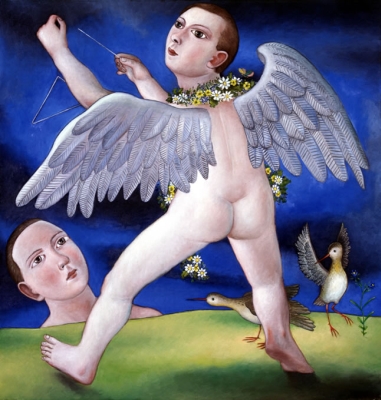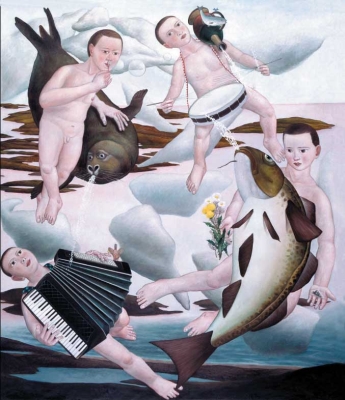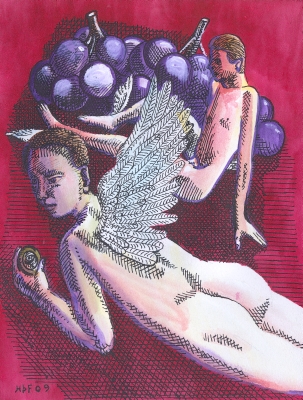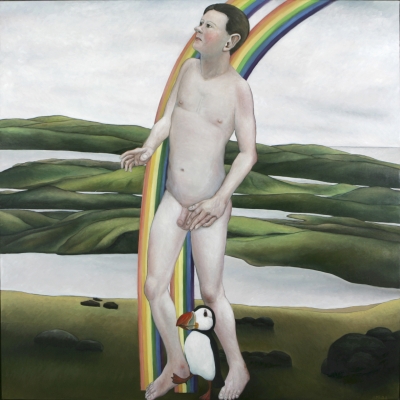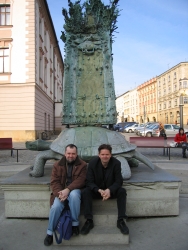 |
||||||||||
|
||||||||||
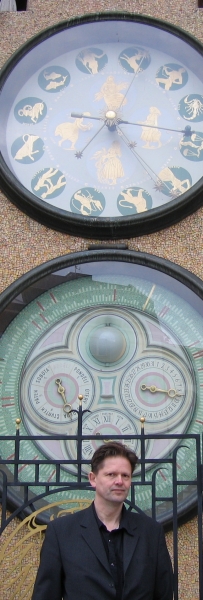 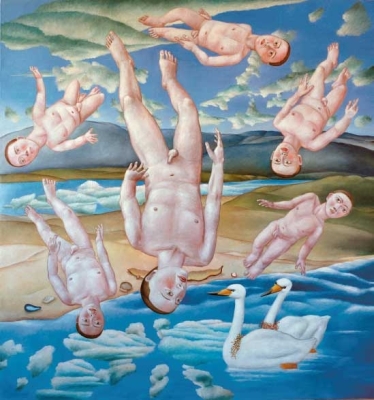 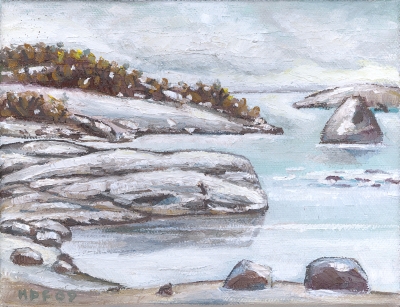 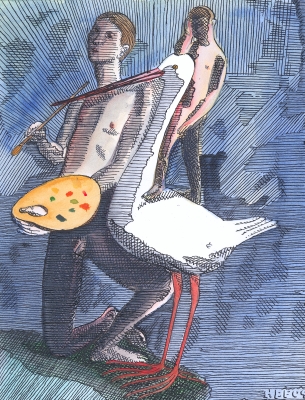 |
Fridjónssonova
olomoucká anabáze Kdybychom se pokusili stručně charakterizovat tvorbu Helgiho Thorgilse Fridjónssona (ročník 1953), pak bychom s trochou nadsázky mohli přirovnat jeho pozici k našemu Josefu Ladovi nebo slovenskému Ľudovítu Fullovi. I přes nespornou společnou sepjatost s rodným prostředím však takové srovnání bude v něčem pokulhávat a pro někoho může být nejen zavádějící, ale i částečně provokativní, a tudíž nepřijatelné. Přesto – klíčem k autorovu dílu je bezpochyby Island a jeho příroda, ale i obráceně – pocity doprovázející vystavené obrazy mohou sloužit jako autentický průvodce po Islandu a jeho nejlepší reklama. Ač se ostrov svojí rozlohou vejde mezi Česko a bývalé Československo, je počet obyvatel hlavního města Reykjavíku srovnatelný s Olomoucí, byť se jedná o třetinu všech Islanďanů. Do Grónska to mají necelých 300 km a na nejbližší evropskou pevninu okolo 800 km. Spíše než relativní izolovanost však spočívá výjimečnost v tom, že tam téměř nerostou stromy, povrch je celý zalitý lávou a počasí se mění ne co pět minut, ale snad každou minutu. Cenným dokumentem je v tomto ohledu soubor fotografií Marka Watsona v Národním islandském muzeu. Nepříliš bohatá – avšak o to specifičtější – flóra a fauna je zachycena jako nedílná součást umělcových obrazů; nicméně – on je především figuralista. Tak se na jeho plátnech objevují kromě různotvarých mraků nejrozmanitější shluky drobných květin a lišejníků, ptáků (racků a papuchalků, labutí a husí, čejek, roháčů a potápek), ryb a krabů, mrožů a tuleňů, severských psů a malých koníků, a to vše vytváří svérázné bizarní prostředí pro levitující lidské postavy. Jejich nahota demonstruje pupeční pouto s přírodou. Často se jedná o autostylizace a autoportréty. Alegorické výjevy (např. skupiny muzikantů připomínající andělské chóry Filippina Lippiho na fresce římského kostela Santa Maria sopra Minerva; Filippino však své anděly samozřejmě oděl) jsou někdy poněkud paradoxně dokomponovány ovocem, včetně jižního. Až o takový paradox se však nejedná, poněvadž banány a pomeranče se běžně pěstují v tzv. zelených domech, což jsou jakési masivní skleníky vyhřívané nesčetnými termálními prameny. Zobrazení obyčejného života kombinovaného se sny a mýty může svádět (a často se tak polemicky děje) teoretiky ke srovnávání se surrealisty a naivisty. Akcent je však evidentně kladen spíše na existenciální pocity (život a smrt, radost a úzkost). Zádumčivá klidná atmosféra však nevyznívá tragicky. Filosofický pohled na svět, jehož základem je soulad a respektování přírody člověkem, umocňuje užití tradičních malířských technik. Často jsou využívány sofistikované optické efekty (symetrie), způsobené odrazy na vodní hladině. Stále více (avšak ne intenzivněji) se na paletě uplatňuje bílá. Kromě již zmíněných výjevů je typické i téma rodiny. Portréty přátel jsou realistické a psychologicky propracované. V sérii padesáti dvou pohledů z okna jeho chaty v pustině (Kjallaksstadir) od ledna do prosince roku 2002 byly unikátně zachyceny rozmary divoké přírody. Kromě převažující malby je Fridjónsson i bravurním kreslířem (výstava v olomoucké Galerii Caesar je i z praktických důvodů založena právě na souboru kolorovaných kreseb), autorem drobných keramických plastik okřídlených naháčů většinou sedících na stejně velkém ovoci, příležitostným fotografem a spisovatelem. Vlastním nákladem vydaná v r. 2002 knížka fejetonů „Grónsko (Graenland)“ může připomínat cestopisné črty Karla Čapka a styl ilustrací zase Kamila Lhotáka. Fridjónsson je znám i jako zakladatel nebo spoluzakladatel řady galerií a organizátor kulturního života. Přestože někteří kunsthistorici přiřazují jeho dílo k mezinárodnímu hnutí tzv. „nové malby (new painting)“, jakožto jednomu z projevů postmoderny, není zařazení do odpovídající kategorie v tomto případě podstatné. Nicméně, i přes rozdílnost projevů se řadí do linie započaté jím obdivovaným Jóhannesem S. Kjarvalem (1885 – 1972). Mohli bychom doplnit i další jména z mezinárodní scény (např. André Bauchant, Kuzma S. Petrov–Vodkin,…), ale zmiňme raději přátelský vztah se členy skupiny Normal (Janem Knapem, Milanem Kuncem a Peterem Angermannem), který u něj zřejmě nezůstal bez odezvy. Z autorů vystavujících v Galerii Caesar bychom snad jisté paralely mohli dohledat i u Antonína Střížka nebo Christiana Macketanze. Protagonista navštívil Olomouc v minulém roce, kdy byla dohodnuta i tato výstava. Jeho návrat je tedy vítanou anabází. Když mě v roce 2006 provázel Islandskou národní galerií, zašeptala při míjení učitelka svým žákům s úctou jeho jméno. Měl jsem tehdy pocit, že Helgi Thorgils Fridjónsson je v nezprofanovaném slova smyslu národním umělcem. Tento pocit mi zůstal a sílí v jistotu. Jan Andres |
|
|
Fridjónsson’s
Olomouc Anabasis If we attempt to briefly described the work of Helgi Thorgils Fridjónsson (b. 1953), then with slight exaggeration we could compare him to the positions of Josef Lada in this country, or Ľudovít Fulla in Slovakia. Even though they certainly share a common bond with their native environment, the comparison however falters a bit and for some it might be not only misleading, but also partly a provocation and even unacceptable. For – the key to the artist’s work is undoubtedly Iceland and its nature, but also vice versa – the feelings which arise from the images on display can serve as an authentic guidebook to Iceland, and its best advertisement. While the island in size is larger than the Czech Republic and smaller than the former Czechoslovakia, the number of inhabitants in the capital city of Reykjavik is comparable to Olomouc, while making up one-third of the population of Iceland. It is less than 300 km from Greenland, but 800 km to the European continent. More pertinent than its relative isolation is its uniqueness, in that there are almost no trees growing there, the surface is covered with lava and the weather can change not in five minutes, but almost every minute. The collection of photographs by Mark Watson in the National Museum in Iceland is testament to the latter. The not-rich – however very specific – flora and fauna are captured as an integral part of the artist’s paintings; nevertheless, he is primarily a figural painter. Thus on his canvasses are found, in addition to various-shaped clouds, the most diverse collections of small flowers and lichens, birds (gulls and puffins, swans and geese, plovers and grebes), fishes and crabs, walruses and seals, huskies and small ponies – all creating a bizarre, peculiar background for levitating human figures. Their nakedness demonstrates their umbilical bond with nature. Often he deals with self-stylisation and self-portraits. Allegorical expressions (for example, groups of musicians reminiscent of the angelic choirs of Filippino Lippi in the frescoes of the Roman Basilica of Santa Maria sopra Minerva; Filippino however of course clothed his angels) are sometimes somewhat paradoxically accompanied with fruit, including tropical fruits. Such a paradox however is not so strange as it might seem, for bananas and oranges are raised there in greenhouses, massive glassed-in structures heated by the innumerable thermal springs. The depiction of ordinary life combined with dreams and myths might tempt (and often polemically does just that) art theoreticians to comparisons with surrealists and naïve painters. The accent here is however evidently placed rather on existential feelings (live and death, joy and angst). The calm, sombre atmosphere however does not have a tragic impact. The philosophical view of the world, the basis of which is harmony and mankind’s respect for nature, is enhanced by the use of traditional painting techniques. Often sophisticated optical effects (symmetry) are used, creating reflections on bodies of water. Still more (though not more intensively) is made of white on his palette. In addition to the themes already mentioned, there is the theme of family. Portraits of his friends are elaborated realistically and psychologically. And in the series of fifty-two views from the window of his rural cabin (Kjallaksstadir) from January to December of 2002, he uniquely captured the expressions and moods of untamed nature. In addition to the predominant paintings, Fridjónsson is also a first-rate draughtsman (the exhibition in Olomouc’s Galerie Caesar is based actually on a collection of colour drawings due to practical reasons), an artist of small ceramic sculptures of winged nudes, the majority sitting on fruit as big as they are, and an occasional photographer and writer. With his own funds he published a book of essays in 2002 called “Graenland” (Greenland), which are something like the travel sketches of Karel Čapek as if illustrated by Kamil Lhoták. Fridjónsson is also well-known as the founder and co-founder of a number of galleries, and as an organiser of cultural events. While some art historians place his work within the international movement of “new painting” as one of the expressions of post-modernism, that category is not all-inclusive. He can also be placed into a line beginning with his beloved Jóhannes S. Kjarval (1885–1972). We could even add more names from the international scene (e.g. André Bauchant, Kuzma S. Petrov–Vodkin, etc.), but let’s mention instead his friendly relationship with members of the Normal group (Jan Knap, Milan Kunc and Peter Angermann) which might have had some impact on him. To artists exhibiting at Galerie Caesar, we could perhaps find parallels with Antonín Střížek or Christian Macketanz. Jan Andres |
|
Narozen
/ Born : 7th. March 1953, Búðardalur, Dalasýsla,
Iceland. Vzdělání
/ Education: Samostatné
výstavy / Solo exhibitions: Kolektivní výstavy
(výběr) / Group exhibitions (selection): 2009 Zastoupení ve sbírkách
/ Works represented in the following museums:
|
|
© Galerie CAESAR





